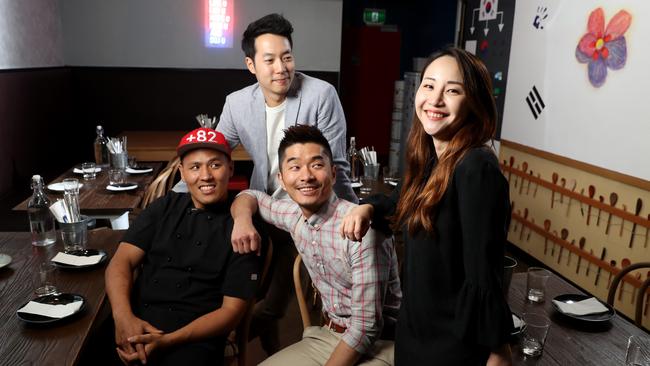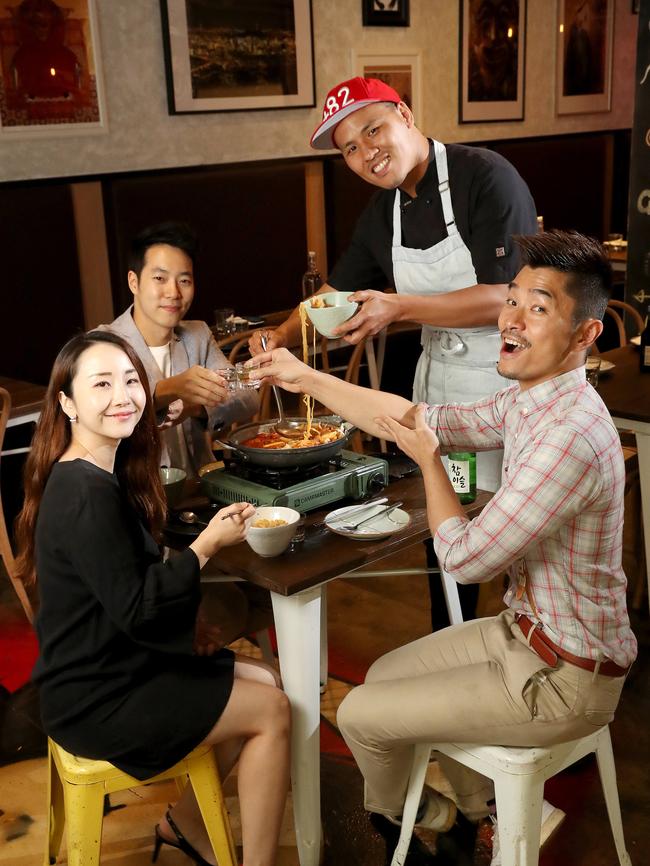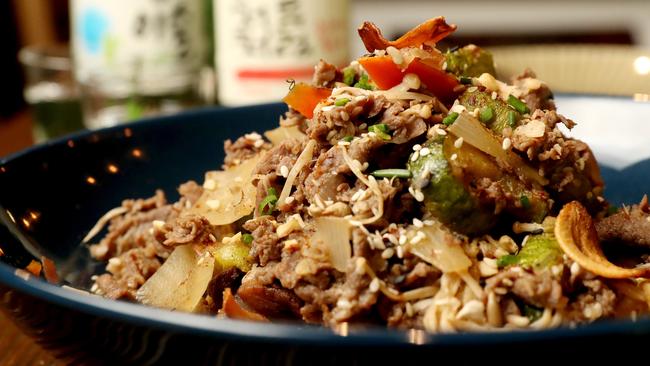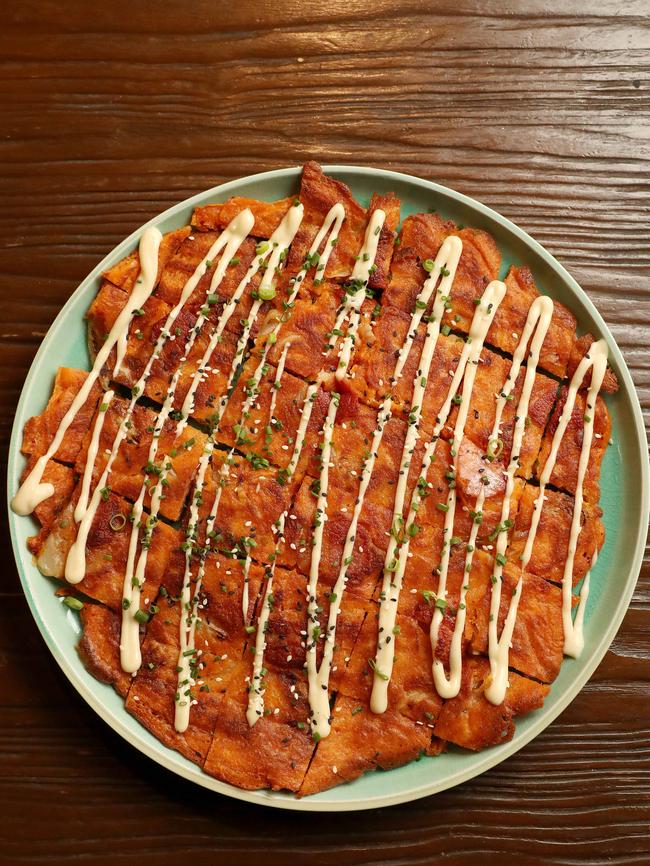Best Korean food in Adelaide’s city and suburbs
FROM healthy rice bowls to addictive fried chicken, kimchi and bulgogi, Korean food is taking over the city. Here’s where to find the best in Adelaide and suburbs. Plus — we look at etiquette in Korean restaurants.

delicious SA
Don't miss out on the headlines from delicious SA. Followed categories will be added to My News.
THE letter “K”, standing for Korea, holds special significance for the cool kids of the world. The nation is the source of a cultural “K-Wave” that has given us K-Pop (remember Gangnam Style), K-hip hop and K-indie, K-drama, K-beauty and K-fashion.
But the trend set to have the biggest and longest-lasting impact, at least in this part of the world, is K-food.
With its combination of light, healthy ingredients, some addictive spice and a mix-and-match, shared-plate philosophy, Korean food seems purpose-built for modern dining trends. Think of it as Japanese with extra flavour oomph and you are on the right track.
In Adelaide, modern Korean diners such as Plus 82 Pocha and contemporary Asian barbecue Shobosho are showing the way. Throw in the hordes of Korean students seeking a taste of home and a well-travelled population (265,000 Australians visited Korea last year alone) and Korean eating options are growing everywhere from food halls to Chinatown to suburban retail strips.
Korean fried chicken is gradually seeing off that other KFC; everyone has an opinion on kimchi; bibimbap rice bowls are becoming a lunchtime favourite; and bulgogi has gone from being a novelty to an almost too obvious choice.
Soju — distilled rice wine — is also appearing increasingly in bottle shops (Dan Murphy’s has 22 options) and bars, where it is even mixed in cocktails. Adelaide even has a specialist soju bar — Juroheunghal on Hindley St.
And the grain liquor makgeolli (pronounced MAHK-oh-lee) is making an appearance in Korean delis and restaurants such as Mr Bulgogi.
Adelaide now offers street food, fine dining, barbecue joints and dumpling bars, but we still have a long way to go before we’re eating in a truly Korean way.
“The problem,” says Jang-Hoon Choi, head chef at modern Korean restaurant Plus 82 Pocha, “is people don’t always understand the science of Korean food — how we make it and how they should eat it.

“Korean is getting popular now, but actually not many people know about it. People go to a Japanese restaurant and know sushi, to a Chinese restaurant and know black bean sauce and beef. But Korean? They think ‘Ah, I know (the song) Gangnam Style,’ but when it comes to food, it’s ‘hmm — I like Korean food but I don’t know the dishes’.”
Jang-Hoon notes that unlike Western eating, where “you might have mashed potato, vegetables and steak, all separated” the true flavour of Korean food comes out in the mix of ingredients and sauces, and the sharing of multiple dishes at the same time — some bulgogi, kimchi, bibimbap, a side plate or two, maybe a hotpot in the centre of the table.
“We have a culture of sharing food,” says Plus 82 Pocha co-owner Hae-Ah Lee. “And the order of eating is not so important.”
For newcomers to Korean food, there’s a benefit to this mixing and sharing — it’s easy to taste a variety of what the Koreans call “uri eumshik” or “our food” in one sitting.
The global trend towards Korean food is also riding on the back of other prevailing movements. Fermented foods are hot right now. As well as the all-conquering kimchi, Korea also offers up jocheong (fermented rice syrup) and kanjang (fermented soy sauce), which can be left to do its thing for decades.
“Foods like kimchi or gochujang paste are all preserved — and preserved food is often full of nutrition. And we Koreans cook it,” Jang-hoon says. “That’s what people are looking for and we’ve got that in our cuisine. I would say Korean food is a superfood.”
And healthy “bowl foods” such as bibimbap are bang on trend, as are the lower-kilojoule options found on Korean menus. “We don’t use much oil in the kitchen compared with Chinese or Western food,” Jang-hoon notes. “So the calorie count is really low. A Korean dinner can be 600 calories (2510kJ), compared with say a pizza which is over 1000 (4200kJ). Also we have spice, and spice increases the metabolic rate through the heat it produces.” The one exception to these healthy, low-kilojoule dishes is Korean fried chicken, aka “KFC”, which is often paired with beer to create a style of dining called chimaek.
“Chicken is something we got from overseas and then changed to our style for the last few decades,” Jang-hoon says.
Until you’ve tried the savoury-sweetness of Korean fried chicken slathered with gochujang sauce, you haven’t found your favourite fried chicken. And nothing goes better with KFC than an easy-drinking Cass or Kloud beer.
Big on taste, healthy (go easy on the KFC) and perfect for sharing, it’s little wonder K-food is experiencing a global boom. Expect the rise and rise of Korean to continue — and enjoy Adelaide’s ever-growing menu of Korean tastes.

BEST KOREAN FRIED CHICKEN
+82 Pocha The place to go for chimaek (chicken and beer). +82’s house-made sweet chilli sauce and garlic/honey sauce are a treat. Shop 3 / 25 Grenfell St, city, 8212 8274, facebook.com/plus82pocha
Mr Bulgogi Despite the name, the chicken here is arguably the standout. Generous serves of tender “KFC” served three ways — plain, sweet and spicy, or soy sauce seasoned.
1/32-36 Metro Parade, Mawson Lakes, 8359 1121, facebook.com/Mr.BulgogiKorenRestaurant
Chef Kim Not strictly “KFC” but the Dak Manul pan-fried garlic chicken provides a more-ish twist on the chicken theme. 4 Linden Ave, Hazelwood Park, 8338 7831, facebook.com/chefkimkoreanrestaurant
BEST DUMPLINGS
Mandoo The only place to go in Adelaide for a wide selection of trad steamed and fried Korean dumplings, made right in front of you. Expect a queue. 3/26 Bank St, city, 8231 3303
Shobosho Kimchi Mandoo is one of Korea’s most popular dumpling offerings, but Shobosho uses garlic scapes in the menu for a new taste and aroma. 17 Leigh St, city; 8366 2224; shobosho.com.au
Koreajung Offers hard-to-find Duk Mandu Guk — rice cake and dumplings in chicken broth with beef and egg. Perfect for winter. 13 Leigh St, city, 8231 9551

BEST NOODLES
Miga Their version of japchae fried potato noodles is possibly the best noodle dish you’ve never tried. 3/474 Payneham Rd, Glynde, 8365 3612
Dami Noodle A little diner offering handmade noodles, noodles hot and cold, and authentic broth. 6/475 Payneham Rd, Felixstow, 8165 2233
Koreajung Want to delve a little deeper into Korea food culture? The hoe naeng myeon cold buckwheat noodles served with fresh raw skate is a Korean warm-weather special.

BEST BULGOGI
+82 Pocha OK, so we’re being a bit cheeky listing a starter as Adelaide’s best bulgogi — but taste the Bulgogi Aranchini tossed with Korean spiced powder (chef’s secret blend) and you too will be hooked.
Chef Kim The “Bul Go Ggi” sees choice cuts of beef, marinated, stir fried and served with three types of mushrooms — a small twist on a Korean classic
Mr Bulgogi And if you want to start at the start, the bulgogi here is simple and unadulterated, beef or spicy pork. The taste is spot on, but the serves are a little small for sharing with a big group.
BEST BARBECUE
Korea Restaurant An often overlooked and underrated Korean food option offering authentic Korean. Cook your own from the Korean BBQ list which includes beef, chicken, lamb, pork belly, ox tongue, seafood and venison. 133 Goodwood Rd, Goodwood; 8272 0066; korearestaurant.com.au
GO-JII You’ve got 100 minutes to scarf as much pork intestine, beef intestine, brisket and pork as you can. Get grilling! 15 Pitt St, city, 8410 0411
Don Don It’s little hit and miss here, but on a good day the service is acceptable and you can tuck into a truckload of wagyu, spicy bulgogi and more. But beware of the pricing — some meats incur extra charges. 184 Hindley St, city, 8212 5557
BEST HOTPOT
+82 Pocha Budae-jjigae is best shared, and +82’s tables allow you to get in close and dig around for the best bits while chatting. Opt to add the ramyun noodles.
Seoul Restaurant A large pork-backbone hotpot at Seoul, Adelaide’s first Korean diner, costs $45 and serves four. Is there a cheaper, tastier and healthier way to feed the family?
BA: M Budae-jjigae, aka Army Base Stew, was first created after the Korean War when food was scarce. Anything that could be smuggled out of US army bases was thrown into the stew. BA: M’s hotpot starts with sausage, ham, fishcake and cheese on noodles, but in these more plentiful times you can add tofu, mushrooms, eggs and veg to your heart’s content. 20 Currie st, city, 8410 5237, facebook.com/Bam.adelaide

BEST JEON PANCAKES
+82 Pocha Thick and packed full of ingredients, this is a luxe version of the jeon you’ll find at most places.
R’n’B It doesn’t get any more trad than pajeon, a simple spring onion pancake. Order it as a secondary dish to share — it goes with everything. 2 Bennett Ave, Melrose Park, 8277 2812, facebook.com/RnB5039
Mr Bulgogi They only do one jeon here — but if you like seafood you’ll love their shrimp, pipi, squid, mussels and baby octopus combo offering. (Chef Kim also does a great seafood jeon).
BEST BIBIMBAP
Chef Kim Beautifully served in a stone pot and tasting fresh and light, Chef Kim’s bibimbap offerings include gluten free and vegan options, including a flavourful tofu dish.
Jin’s Bibimbar Build your own bibimbap. White rice or brown, a choice of veg and meat, seafood or tofu — all topped with your pick of sauce. 480 Goodwood Rd, Cumberland Park, 7073 3971, facebook.com/jinsbibimbar/
Mr Bulgogi In addition to the usual spicy meat offerings, Mr Bulgogi serves up a vegetarian avocado bibimbap.
And look out for +82 Lite, sister venue to +82 Pocha, opening soon in Gawler Place.
THE A-Z OF CHOPSTICK TRICKS AND ETIQUETTE
ALCOHOL Don’t drink alcohol directly in front of elders (even those just a little older than you). Twist your body to one side to drink.
BANCHAN These are side dishes. Don’t hoard them and never take the last item on each dish
BAP is easy — it means rice (but also means meal).
BOWLS Keep rice and soup bowls on the table; do not pick them up. “Japanese don’t use a spoon, so it’s really hard for them to pick up the rice with their chopsticks, so they have to hold the bowl,” says Hae-Ah Lee of Plus 82 Pocha. “Whereas Koreans use spoons, so we leave everything on the table.” Do not touch the bowl with your mouth.

CHOPSTICKS Do not stick your chopsticks (or a spoon) in your bowl of rice. Leave your chopsticks on the rest provided or on the side of your plate. If you find it difficult to use metal chopsticks, it’s perfectly acceptable to ask for a knife and fork (but learning to use chopsticks well will earn you praise).
CUTLERY Do not hold your chopsticks and a spoon at the same time.
DRINKS Ensure that those who are senior to you have their drinks topped up first. Also offer to top up your neighbour’s glass once it is half-empty. Your neighbour will do the same for you.
DESSERT Korean restaurants rarely offer dessert but a few basic ones such as patbingsu — shaved ice topped with syrup, fruit, condensed milk or adzuki beans — are starting to become more commonplace.
EATING Try not to rush or linger as you eat, just keep pace with others (while taking note of the seniority rules below). Don’t take too much food — you’ll be expected to finish everything on your plate as a sign of respect.
FINISHED When finished, place your utensils to the right side of the bowl, facing directly vertical.
GOCHUJANG This is the base sauce for dishes including spicy pork, bul duk (fire chicken) and “KFC” (Korean fried chicken).

G v K Spelling Korean words with a G instead of a K is becoming more common and more accurately reflects the way words should be spoken. So kimchi will sometimes be written
as gimchi, kochujang sauce is already more commonly called gochujang sauce.
HANDS Don’t use your hands to pick up food — not even difficult-to-grab items such as nuts or rice grains. The exception is leaves used as a wrap. They can be held while using chopsticks to put ingredients inside the wrap.
HANJEONSIK A lavish 12-course meal first associated with the royal family but now available at special-occasion restaurants.
JAL MUKGESSEUMNIDA means “I ate well” (but is taken to mean “thank you for this good food”). It should be said when you’ve finish eating.
KFC Korean Fried Chicken.
KIMCHI (also called Gimchi) There are more than 150 variations on kimchi, with each Korean region boasting at least one special kimchi recipe.
LEAVING THE TABLE Do not leave when everyone is eating (go to the bathroom beforehand). The only exception is to blow your nose if you feel a sneeze coming on.
MEAL ORDER It’s best to taste your soup or stew first then the rice then the sides. But this is not a hard and fast rule.
NAPKIN Placing your used napkin on the table tells restaurant staff that you’ve finished.
ONE BITE Eat lettuce-wrapped meats in one bite.
OI — no, not Aussie, Aussie, Aussie, oi, oi, oi! In Korean, oi means cucumber.
POURING Always pour drinks or hold your cup using two hands.
REACHING Don’t extend your arm a long way across the table to reach a shared dish.
SENIORITY Only start eating after the eldest person at the table has begun. And don’t finish your food until the eldest has.
SHARE DISHES Do not poke at or dig around in share dishes. Try not to touch shared food that you don’t intend to eat.
SHOES In Korea, you’ll likely be asked to remove your shoes before stepping into the dining area — so ensure you’re wearing fresh, hole-free socks.
TALKING Do not talk loudly while eating. Don’t talk with a mouth full.
UNWANTED ITEMS Bones and other items should be discreetly wrapped in paper. Don’t put them on the table or in an empty bowl.
WATER Younger people should pour water for everyone before eating. Unlike with alcohol, it is preferable for the youngest members of the table to pour their own water.
YOLI NEOMU JALHASEYO means “You’re a great cook” and is the best way to compliment your host. Say it during and after the meal.


